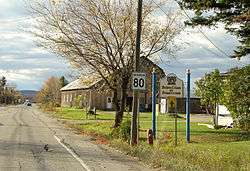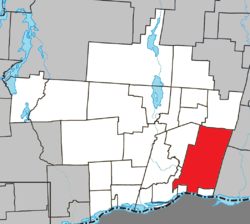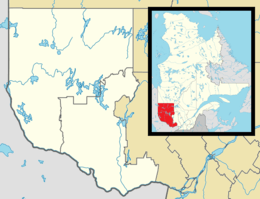Notre-Dame-de-Bonsecours, Quebec
Notre-Dame-de-Bonsecours is a municipality in the Outaouais region of Quebec, Canada. It is located along the Ottawa River, about 55 kilometres (34 mi) east of Gatineau. It was formerly known as Notre-Dame-de-Bon-Secours-Partie-Nord. It is the least populated municipality in the Papineau Regional County Municipality.
Notre-Dame-de-Bonsecours | |
|---|---|
Municipality | |
 | |
 Location within Papineau RCM | |
 ND-de-Bonsecours Location in western Quebec | |
| Coordinates: 45°42′N 74°52′W[1] | |
| Country | Canada |
| Province | Quebec |
| Region | Outaouais |
| RCM | Papineau |
| Constituted | March 7, 1918 |
| Government | |
| • Mayor | Denis Beauchamp |
| • Federal riding | Argenteuil—Papineau—Mirabel |
| • Prov. riding | Papineau |
| Area | |
| • Total | 281.30 km2 (108.61 sq mi) |
| • Land | 264.97 km2 (102.31 sq mi) |
| Population (2016)[3] | |
| • Total | 301 |
| • Density | 1.1/km2 (3/sq mi) |
| • Pop 2011-2016 | |
| • Dwellings | 202 |
| Time zone | UTC−5 (EST) |
| • Summer (DST) | UTC−4 (EDT) |
| Postal code(s) | J0V 1L0 |
| Area code(s) | 819 |
| Highways | |
| Website | www |
The northern portion of the municipality is undeveloped wilderness, mostly part of the Kenauk Reserve. This 260 square kilometres (100 sq mi) protected wilderness domain was formerly known as "Reserve de la Petite Nation", but is now a privately owned fish and game reserve of Château Montebello.[4]
History
The area was part of the Petite-Nation Seigneury, formed in 1674 [5] and originally owned by François de Laval, the first bishop of New France. The seigneury was acquired in 1803 by Joseph Papineau, who became its first civilian lord, and later sold it to his son Louis-Joseph Papineau.[6]
The area became of interest economically when England was forced to rely on its colonies for wood for construction of its vessels during the Napoleonic blockade of 1807. It was full of oaks, pines, and maples regarding which Surveyor Joseph Bouchet wrote in 1815: "the terrain rises and is covered with wood of the best species: oaks are of high quality and particularly of large size, suitable for the construction of vessels."[6]
In 1815 the original mission of Notre Dame de Bonsecours was created and in 1821 a chapel dedicated to Notre-Dame de Bonsecours (Our Lady of Good Help) was constructed. On September 31, 1831, the bishop of Quebec Bernard-Claude Panet granted a petition signed by Denis-Benjamin Papineau and over 75 tenants for the formation of a parish. His decree called the new parish Notre-Dame-de-Bonsecours-de-la-Petite-Nation and also recommended the people of Bonsecours to acquire civil recognition from the Governor General of Canada, Lord Aylmer.[6]
On June 18, 1845, the Governor General of the Province of Canada, Charles Metcalfe, established local and municipal authorities in Lower Canada, under a new law passed by the provincial Parliament.[7] One of the new municipalities established was the Municipality of Petite-Nation, which included the Parish of Notre-Dame-de-Bonsecours-de-la-Petite-Nation. However, this municipality was abolished in 1847.[6]
On July 1, 1855, a new statute of the Province of Canada came into force,[8] which allowed the parish to get official civilian recognition, known as Parish Municipality of Notre-Dame-de-Bon-Secours-de-la-Petite-Nation.[5][6]
On August 22, 1878, Montebello separated from the parish municipality.
In the 1870s, the Quebec, Montreal, Ottawa and Occidental Railway was built, connecting Montreal to Ottawa. The rail-line went through the municipality of Notre-Dame, in the area of the municipality which is now Fassett. The Canadian Pacific Railway bought the line in 1882.[9]
In the late 1890s, there was a dispute between the municipality of Notre-Dame-de-Bonsecours and the Canadian Pacific Railway, which resulted in a court case that went all the way to the Judicial Committee of the Privy Council in Britain, the highest court of appeal for the British Empire. A ditch beside the rail-line had become clogged, resulting in flooding on the neighbouring land, owned by Julien Gervais. The municipality issued an order to the CPR, directing it to clean the obstruction. The CPR refused, arguing that as a federally incorporated railway, it was not required to comply with provincial law. The Quebec courts held that the provincial law did apply,[10] and the CPR appealed to the Judicial Committee. In 1899, the Judicial Committee ruled in favour of the municipality and upheld the order to clean the ditch, in the case of Canadian Pacific Railway Co. v Notre Dame de Bonsecours.[11] The decision of the Judicial Committee continues to be cited with approval by the Supreme Court of Canada.[12]
In 1918, the large rural and forested area of the parish municipality separated and formed the Parish Municipality of Notre-Dame-de-Bon-Secours-Partie-Nord. In 1951, the Parish Municipality of Notre-Dame-de-Bon-Secours became the Municipality of Fassett. And in 2003, the Parish Municipality of Notre-Dame-de-Bon-Secours-Partie-Nord became the Municipality of Notre-Dame-de-Bonsecours.[5]
Demographics
| Canada census – Notre-Dame-de-Bonsecours, Quebec community profile | |||
|---|---|---|---|
| 2016 | 2011 | ||
| Population: | 301 (15.3% from 2011) | 261 (-5.1% from 2006) | |
| Land area: | 264.97 km2 (102.31 sq mi) | 266.90 km2 (103.05 sq mi) | |
| Population density: | 1.1/km2 (2.8/sq mi) | 1.0/km2 (2.6/sq mi) | |
| Median age: | 54.2 (M: 53.5, F: 55.5) | 52.2 (M: 52.0, F: 52.3) | |
| Total private dwellings: | 202 | 158 | |
| Median household income: | $47,488 | $64,012 | |
| References: 2016[13] 2011[14] earlier[15] | |||
| Year | Pop. | ±% |
|---|---|---|
| 1986 | 300 | — |
| 1991 | 248 | −17.3% |
| 1996 | 273 | +10.1% |
| 2001 | 284 | +4.0% |
| 2006 | 275 | −3.2% |
| 2011 | 261 | −5.1% |
| 2016 | 301 | +15.3% |
| Source: Statistics Canada | ||
Mother tongue:[3]
- English as first language: 5.1%
- French as first language: 91.5%
- English and French as first language: 3.4%
- Other as first language: 0%
Education
Sir Wilfrid Laurier School Board operates Anglophone public schools:
- Laurentian Regional High School in Lachute[16]
References
- Reference number 379133 of the Commission de toponymie du Québec (in French)
- Geographic code 80015 in the official Répertoire des municipalités (in French)
- "(Code 2480015) Census Profile". 2016 census. Statistics Canada. 2017.
- "Fairmont Kenauk Hotel History". Retrieved 2008-10-24.
- "Notre-Dame-de-Bonsecours (Municipalité)" (in French). Commission de toponymie du Québec. Archived from the original on 2016-03-03. Retrieved 2008-10-20.
- Jacques Lamarche. "Historique" (in French). Municipalité de Notre-Dame de Bonsecours. Archived from the original on 2009-10-06. Retrieved 2008-10-20.
- An Act to repeal certain Ordinances therein mentioned, and to make better provision for the establishment of Local and Municipal Authorities in Lower Canada, S.Prov.C. 1845, c. 40.
- Lower Canada Municipal and Road Act, S.Prov.C. 1855, c. 100.
- Quebec, Montreal, Ottawa and Occidental Railway - Useful Information for Ottawa area Genealogists and Local Historians
- Cie de Chemin de Fer Canadien du Pacifique v Notre-Dame-de-Bonsecours (Paroisse), 1897 CarswellQue 80, 7 Que. QB 121, para. 8.
- Canadian Pacific Railway Co. v Notre Dame de Bonsecours, [1899] AC 367 (PC), [1899] UKPC 22 (UKPC).
- Ontario v. Canadian Pacific Ltd., [1995] 2 SCR 1028.
- "2016 Community Profiles". 2016 Canadian Census. Statistics Canada. February 21, 2017. Retrieved 2020-01-30.
- "2011 Community Profiles". 2011 Canadian Census. Statistics Canada. July 5, 2013. Retrieved 2020-01-30.
- "2001 Community Profiles". 2001 Canadian Census. Statistics Canada. February 17, 2012.
- "LAURENTIAN REGIONAL HS ZONE." Sir Wilfrid Laurier School Board. Retrieved on September 4, 2017.
External links
![]()